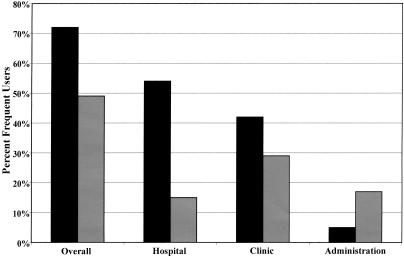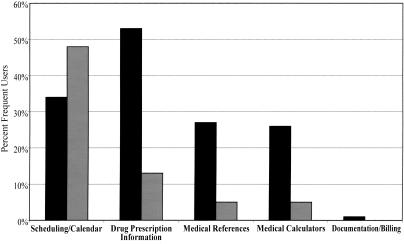Abstract
Limited information is available on personal digital assistant (PDA) use patterns in medical settings. Recognizing that use patterns may be important considerations for development of handheld-based information systems, the authors characterized PDA use at their institution. A survey was mailed to all internal medicine physicians at the Mayo Clinic, Rochester, Minnesota, in May 2002. PDA use prevalence, user demographics, hardware preferences, and work setting and application use frequencies were assessed for respondents reporting current PDA use. Use patterns of trainees (residents and subspecialty fellows) and attending physicians were compared. Trainees reported more frequent PDA use in the hospital setting and for direct patient care. Attending physicians reported more frequent PDA use in administrative settings and for calendar functions. These findings may reflect differences in the information needs and work roles of learners and experienced physicians. Such factors may be important considerations for the development and implementation of institutional PDA resources.
Information management in medicine poses a formidable challenge.1 Prior studies have addressed this issue from the standpoint of physician information needs2,3 and what resources might help meet these needs. Handheld computers, often referred to as personal digital assistants (PDAs), have ushered in a new era in information management. Device portability and useful software allow application of current medical knowledge at the point of care. Recent literature reports have highlighted the prominent PDA use among physicians4,5 and the wide variety of medical applications for this technology.6
Some academic medical centers have begun to integrate handheld resources into their information technology infrastructure.7 Ideally, development of institutional PDA resources should be based on the information needs and use patterns of physicians who use these devices. Recognizing that information needs of trainees may differ from those of attending physicians3, we hypothesized that use patterns of PDAs would differ significantly between these groups. To investigate this hypothesis, we utilized a survey instrument to define PDA use patterns among trainees and attending physicians at our institution.
Methods
Study Population
The survey was conducted in the Department of Internal Medicine at the Mayo Clinic, a multispecialty, tertiary care academic medical center in the Midwest. The Department of Internal Medicine comprises 514 general and subspecialty internal medicine attending physicians, 143 residents, and 186 subspecialty fellows.
Survey Development and Administration
An 11-item survey was designed (▶). Questions focused on PDA user demographics, hardware and operating systems (OS), and use patterns. Use pattern items rated frequency of PDA use in different settings (hospital, outpatient clinic, and administration), and of different application categories (scheduling/calendar, drug prescription information, medical references, medical calculators, and documentation/billing). The survey was mailed to 867 residents, subspecialty fellows, and attending physicians in the Department of Internal Medicine in May 2002. Survey responses were anonymous.
Table 1.
Personal Digital Assistant (PDA) Usage Survey
| 1. Do you currently use a personal digital assistant (PDA)? |
| 2. Indicate the brand of your current PDA. |
| 3. For how long have you used a PDA? |
| 4. For what purpose do you mostly use your PDA? |
| (Work-related, personal activities, both) |
| 5. How frequently do you use your PDA in the following settings? |
| (Clinic, hospital, administration) |
| 6. How frequently do you use your PDA for the following applications? |
| (Scheduling/calendar, documentation/billing, drug information, medical references, medical calculators) |
| 7. How helpful would it be to have the following applications on your PDA for your typical clinical involvements? |
| (Scheduling/calendar, documentation/billing, drug information, medical references, medical calculators) |
| 8. What is your current position? |
| (Resident, fellow, attending) |
| 9. What is your specialty? |
| 10. What is your current age? |
| 11. Are you: Male/Female? |
Statistical Analysis
Responses to all survey items were abstracted and compiled. For purposes of further analysis, physician status was classified into two groups: attendings and trainees. The attendings group comprised faculty of the Department of Internal Medicine. The trainees group comprised all departmental residents and subspecialty fellows.
The group of physicians reporting current PDA use was evaluated in depth. Survey hardware and use pattern items for this dataset were tabulated by percentages overall, position, age strata, and gender. Responses to use pattern items (setting and applications) were dichotomized as “frequent use” (more than five times per day) versus “infrequent use” (five or fewer times per day). Chi-square tests were used to determine whether responses to hardware and use pattern questions differed by group. McNemar's tests were used to determine pair-wise whether frequency differed by setting or by application. SAS (SAS Institute, Inc., Cary, NC) and S-PLUS (Insightful Corp., Seattle, WA) statistical packages were used for these analyses.
Results
Response Rates and User Demographics
Of 867 mailed surveys, 473 were returned completed (overall response rate, 55%). Response rates were higher for men than women (57% vs. 43%; p = 0.006), and increased with age strata (< 30 years, 42%; 30 to 39 years, 51%; 40+ years, 62%; p = 0.0001).
The proportion of respondents who reported current PDA use was 46% (218 of 473) and comprised 95 trainees and 123 attendings. Use prevalences decreased with increasing age (< 30 years, 68%; 30 to 39 years, 51%; 40+ years, 37%; p < 0.0001) and were not statistically different for male versus female physicians (48% vs. 38%; p = 0.008). Use of a Palm OS (Palm, Inc., Milpitas, CA) device was reported by 90% while 10% used a device utilizing the Microsoft Pocket PC OS (Microsoft Corp., Redmond, WA).
Use Patterns—Work Setting
Personal digital assistant use rates for attending physicians and trainees varied by work setting (▶). Use in the hospital setting was more frequent for trainees than attendings (54% vs. 15%; p < 0.0001) and for younger respondents (< 30 years, 68%; 30 to 39 years, 35%; 40+ years, 15%; p < 0.0001). In the outpatient clinic setting, there was a nonsignificant trend toward more frequent use by trainees than attending physicians (42% vs. 29%; p = 0.07). Reported frequent use in administrative settings was more common for attending physicians than trainees (17% vs. 5%; p = 0.007) and for older respondents (< 30 years, 3%; 30 to 39 years, 9%; 40+ years, 18%; p = 0.04).
Figure 1.
Frequent PDA use by work setting. Black bars indicate trainees. Gray bars indicate attending physicians.
Use Patterns—PDA Applications
Significant differences in use frequency between trainees and attending physicians were noted for a variety of PDA applications (▶). Specifically, reported frequent use of scheduling/calendar applications was higher for attending physicians than trainees (48% vs. 34%; p = 0.03). Trainees, however, were more likely than attending physicians to report frequent use of patient care resources, including drug information programs (53% vs. 13%; p < 0.0001), medical references (27% vs. 5%; p < 0.0001), and medical calculators (26% vs. 5%; p < 0.0001). Frequent use of documentation/billing applications was reported by very few physicians and did not differ significantly between trainees and attending physicians (1% vs. 0%; p = 0.26).
Figure 2.
Frequent PDA use by application. Black bars indicate trainees. Gray bars indicate attending physicians.
Discussion
In this study, a survey instrument effectively found significant differences in PDA use patterns between internal medicine trainees and attending physicians at our institution. In particular, trainees reported more frequent PDA use in the hospital setting and for patient care programs (references and medical calculators). Attending physicians reported more frequent PDA use in administrative settings and for scheduling/calendar applications. Palm OS devices were preferred over Pocket PC devices by a significant majority of PDA users at our institution.
The differing use rates for various PDA applications noted in our study may result from a number of interrelated factors. These include work setting, physician role, and experience/knowledge level. Work setting may determine the role a resident or attending physician plays in patient care, which may, in turn, influence whether the physician uses a particular PDA application. Attending physicians supervising on the hospital service may be more involved in teaching than active patient care issues, and, therefore, less likely to consult their PDA for patient care resources. Residents, on the other hand, have “front-line” patient care responsibilities and might be expected to rely more heavily on references and medical calculators. Previous work has suggested that such work role differences may influence PDA use patterns.8
A clear preference for Palm OS devices over Pocket PC devices was noted among physician PDA users at our institution and has been similarly shown in other investigations.4,5 From the standpoint of both individual and institutional resource development, these findings suggest that continued design of applications and support services based on the Palm OS platform may be more likely to benefit the majority of physician PDA users. Functionality, availability of software, and ease of mastery have been suggested as influential factors in choice of device and operating system.6 Future investigations might more precisely elucidate profession-specific factors that could prove useful in operating system upgrades and device design (Palm or Pocket PC).
We recognize several limitations of the use of a survey instrument for evaluating PDA use patterns. Our overall response rate was 55%, and we did not identify or survey nonrespondents. As such, it is possible that our group of respondents was not representative of physicians in the Department of Internal Medicine as a whole. Use prevalence and use pattern information could be distorted under these circumstances. It is reassuring to note that our group of respondents reporting current PDA use was similar to the entire survey pool in age and gender breakdown (46% of the survey pool were older than 40 years and 75% were men compared with 42% and 83%, respectively, for our responders reporting current PDA use).
Recall bias also is a relevant concern. Responses to survey items were based on individual recollection rather than electronic audits of application use. This might compromise the accuracy of reported application use frequency. However, we would expect bias of this nature to be evenly distributed across our two groups of physician PDA users. We attempted to minimize difficulties in this regard by defining broad, easy-to- remember ranges for use frequency in the survey (never, < 1 time per day, 1 to 5, 6 to 10, and >10 times per day).
Finally, limiting our survey to the Department of Internal Medicine at only one academic medical center may compromise the generalizability of our results to other institutions, medical practices, or specialties. Specialty stratification of large, multicenter study populations could minimize limitations of this type.
References
- 1.Williamson JW, German PS, Weiss R, Skinner EA, Bowes F. Health science information management and continuing education of physicians. A survey of US primary care practitioners and their opinion leaders. Ann Intern Med. 1989;110:151–60. [DOI] [PubMed] [Google Scholar]
- 2.Connelly DP, Rich EC, Curley SP, Kelly JT. Knowledge resource Preferences of family physicians. J Fam Pract. 1990;30:353–9. [PubMed] [Google Scholar]
- 3.Gorman PN. Information needs of physicians. J Am Soc Info Sci. 1995;46:729–36. [Google Scholar]
- 4.ACP-ASIM survey finds nearly half of U.S. members use handheld computers. ACP-ASIM Online. Oct 25, 2001. <http://www.acponline.org/college/pressroom/handheld_survey.htm>. Accessed December 16, 2002.
- 5.Criswell DF, Parchman ML. Handheld computer use in U.S. family practice residency programs. J Am Med Inform Assoc. 2002;9:80–6. [DOI] [PMC free article] [PubMed] [Google Scholar]
- 6.Fischer S, Stewart TE, Mehta S, Wax R, Lapinsky SE. Handheld computing in medicine. J Am Med Inform Assoc. 2003;10:139–49. [DOI] [PMC free article] [PubMed] [Google Scholar]
- 7.Professional experiences—Wake Forest Medical Center using Palm OS PDAs to train tomorrow's doctors. pdaMD.com. <http://www.pdamd.com/vertical/tutorials/wake_forest.xml>. Accessed December 16, 2002.
- 8.Manning B, Gadd CS. Introducing handheld computing into a residency program: preliminary results from qualitative and quantitative inquiry. Proc AMIA Symp. 2001:428–32. [PMC free article] [PubMed]




